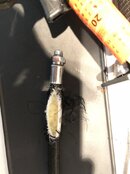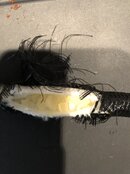scuba2you
Registered
This is a personal Incident that happened to me two years ago, I wasn't an active board member at the time so here's my belated summary. Old lesson learned even after 30 years diving......
This incident took place on a live aboard in Raja Ampat. My regs were completely overhauled 90 days prior to the incident.
The first indication of the problem occurred during the initial decent as I noticed the regulator became slightly more restrictive trying to breathe, then seemed to clear and I continued the decent, adjusting the knob on the regulator. I also noticed bits of debris in my mouth at different times but assumed this was from my custom bite piece since I tend to grind or bite hard on the mouthpiece.
At approximately 25 meters the regulator suddenly began free flowing as I took in a breath, I was unable to breathe (outside of pulling in air off the bubbles) or stop it in any way, I switched to my backup which allowed for normal breathing. I tried for approximately 2 minutes to get the regulator to stop the free flow to no avail. At about this time I was joined by the dive master of the boat who noticed the problem and came over to assist. We both worked on it another minute, then it suddenly stopped with about 1200 psi remaining in the tank. I switched back to the primary and noticed it was very difficult to breathe and would free flow with just a moderate pull of air on the regulator. We aborted the dive together and finished the dive without further incident.
On the boat we felt the problem was in the primary regulator so we attempted to switch the two regulators. However when we detached the primary from the hose we noticed bits of crystallized rubber in the inlet orifice of the regulator. Initially we thought this might be some seal failure but research led us to a Dan article indicating likely hose failure.
When I returned home, I noted the rubber swivel hose was seven years old and likely the issue as it was the hose connected to the problem regulator. I cut the hose and examined the inside, it was in excellent condition visually, with no signs of any deterioration. Next, I decided to look at the secondary braided non OEM hose using a process recommended by DAN.
Physically examine hoses by squeezing them every inch or so to assess whether they exhibit the same degree of flexibility. Any change in resistance while squeezing along the length of the hose would be a sign of a possible problem. This test is much easier to perform with braided hoses than with harder, outer rubberized hoses.
The secondary braided yellow hose dated 2008 seemed to pass this test, and the regulator had no problem when used as a backup so I thought this was not the problem either.
Just to be thorough, I did the same with the low pressure inflator hose and immediately felt the soft areas of the hose, internally the hose lining was just a bunch of hardened crystals, this hose did not have a date code and had completely failed, small bits of material were coming from the inflator hose, passing through the first stage and blocking the second stage. Based on this it was only a matter of luck that I did not lose both the primary and the secondary on the dive resulting in a complete loss of air.
My braided aftermarket inflator hose was from a well known supplier, there is no desire to bash anyone here, I should be checking my hoses and replacing them on a scheduled basis. Also, based on an examination of all my hoses which were cut open vertically and studied, its my opinion (I'm an electrical engineer not a materials science engineer) that high quality reinforced rubber hoses are more durable than braided hoses over time.
Check those Inflator hoses, a failure there could be more dangerous than you think.
Btw, I never fully had it explained to me how debris from an inflator hose could pass up through the first stage and into my regulator, any techs or manufactures that can help me understand this?
This incident took place on a live aboard in Raja Ampat. My regs were completely overhauled 90 days prior to the incident.
The first indication of the problem occurred during the initial decent as I noticed the regulator became slightly more restrictive trying to breathe, then seemed to clear and I continued the decent, adjusting the knob on the regulator. I also noticed bits of debris in my mouth at different times but assumed this was from my custom bite piece since I tend to grind or bite hard on the mouthpiece.
At approximately 25 meters the regulator suddenly began free flowing as I took in a breath, I was unable to breathe (outside of pulling in air off the bubbles) or stop it in any way, I switched to my backup which allowed for normal breathing. I tried for approximately 2 minutes to get the regulator to stop the free flow to no avail. At about this time I was joined by the dive master of the boat who noticed the problem and came over to assist. We both worked on it another minute, then it suddenly stopped with about 1200 psi remaining in the tank. I switched back to the primary and noticed it was very difficult to breathe and would free flow with just a moderate pull of air on the regulator. We aborted the dive together and finished the dive without further incident.
On the boat we felt the problem was in the primary regulator so we attempted to switch the two regulators. However when we detached the primary from the hose we noticed bits of crystallized rubber in the inlet orifice of the regulator. Initially we thought this might be some seal failure but research led us to a Dan article indicating likely hose failure.
When I returned home, I noted the rubber swivel hose was seven years old and likely the issue as it was the hose connected to the problem regulator. I cut the hose and examined the inside, it was in excellent condition visually, with no signs of any deterioration. Next, I decided to look at the secondary braided non OEM hose using a process recommended by DAN.
Physically examine hoses by squeezing them every inch or so to assess whether they exhibit the same degree of flexibility. Any change in resistance while squeezing along the length of the hose would be a sign of a possible problem. This test is much easier to perform with braided hoses than with harder, outer rubberized hoses.
The secondary braided yellow hose dated 2008 seemed to pass this test, and the regulator had no problem when used as a backup so I thought this was not the problem either.
Just to be thorough, I did the same with the low pressure inflator hose and immediately felt the soft areas of the hose, internally the hose lining was just a bunch of hardened crystals, this hose did not have a date code and had completely failed, small bits of material were coming from the inflator hose, passing through the first stage and blocking the second stage. Based on this it was only a matter of luck that I did not lose both the primary and the secondary on the dive resulting in a complete loss of air.
My braided aftermarket inflator hose was from a well known supplier, there is no desire to bash anyone here, I should be checking my hoses and replacing them on a scheduled basis. Also, based on an examination of all my hoses which were cut open vertically and studied, its my opinion (I'm an electrical engineer not a materials science engineer) that high quality reinforced rubber hoses are more durable than braided hoses over time.
Check those Inflator hoses, a failure there could be more dangerous than you think.
Btw, I never fully had it explained to me how debris from an inflator hose could pass up through the first stage and into my regulator, any techs or manufactures that can help me understand this?







